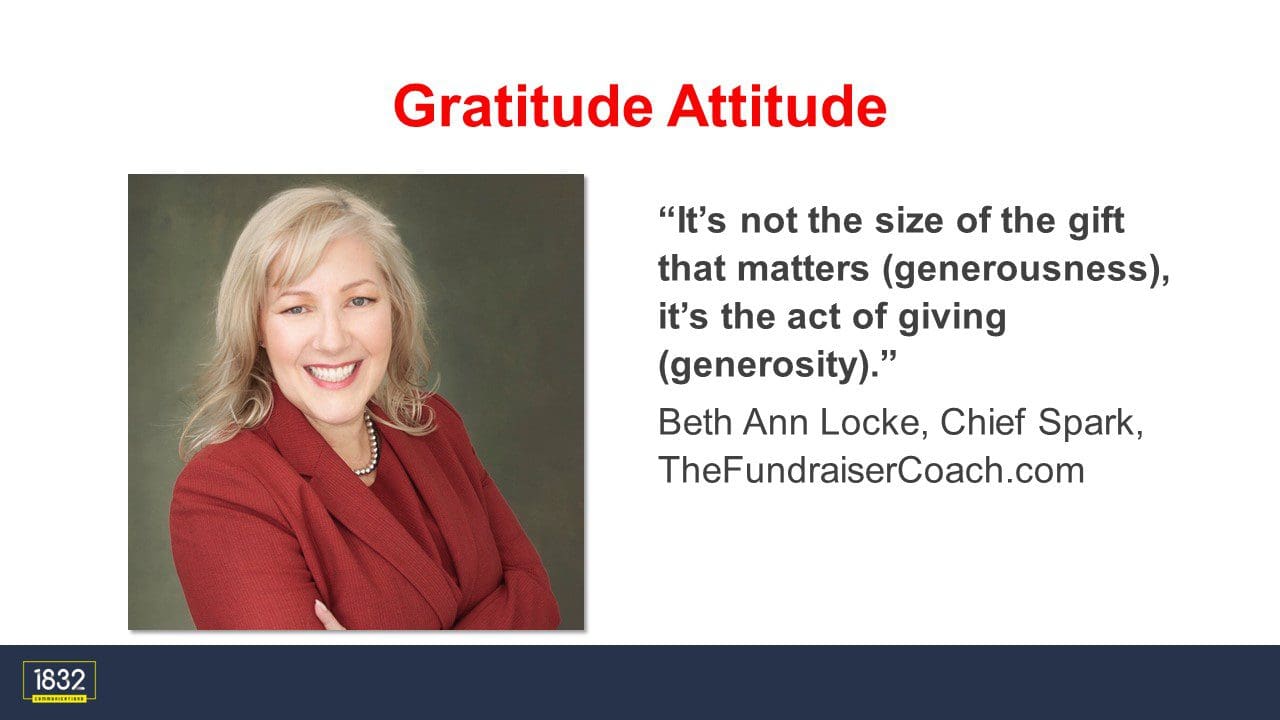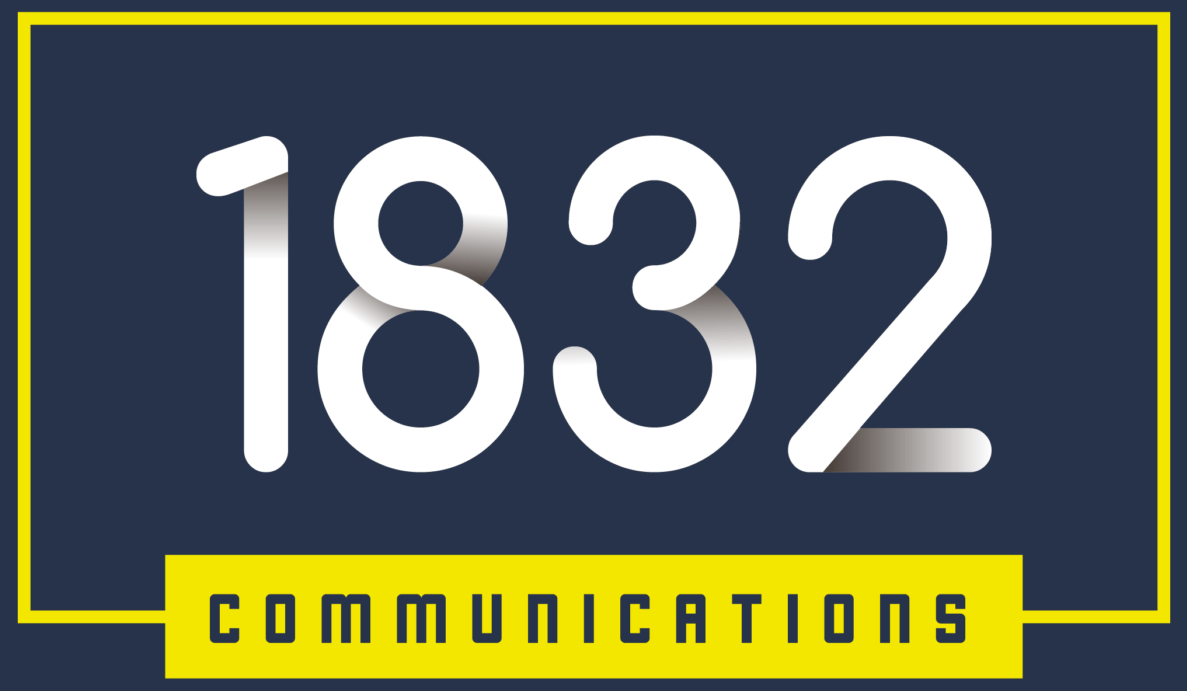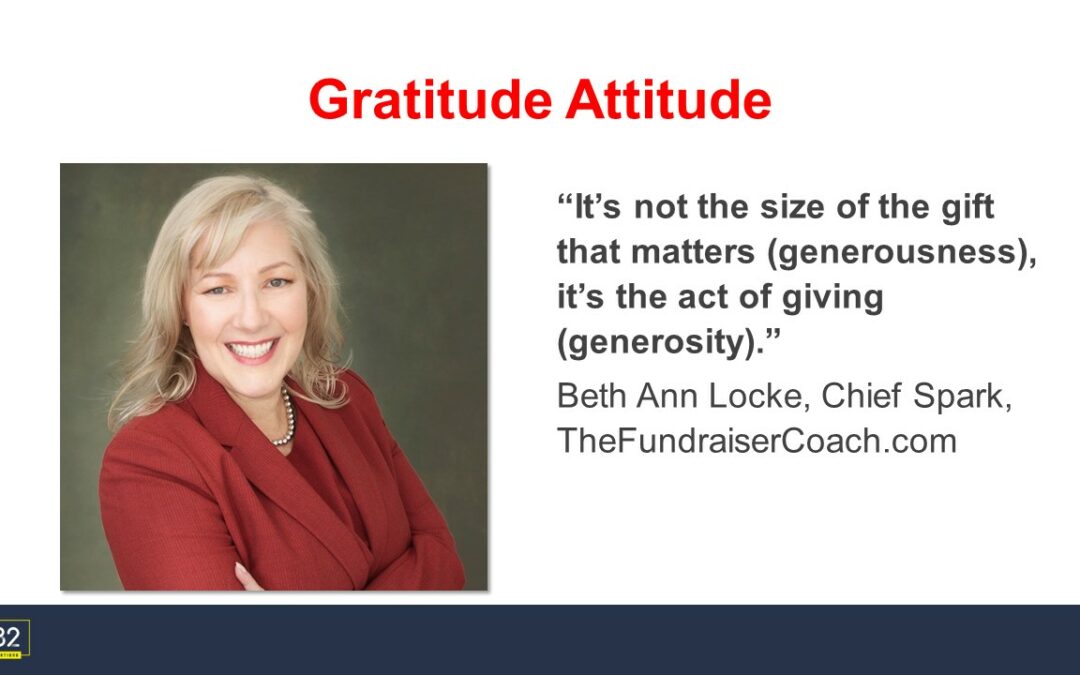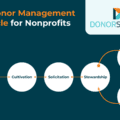A homeless man saw the CEO of a local United Way picking up donated food at a soup kitchen. He walked up to the CEO and said, “I want to make a donation” and handed her a quarter. “This is lovely,” she replied. “I’ll make sure the soup kitchen gets it.”
A month later, they met again and he said, “It’s time for me to make a donation again.” He gave her a quarter. She said, “Well, now it’s official, you’re a monthly donor!” He walked away with a grin on his face.
I share this story not only because I love it but because it teaches us an important lesson: No amount is too small. A quarter was 100% of what that man could give. His donation needs to be celebrated just as much as if he donated $25,000.
In a recent national survey I conducted (more to come), I read and heard grant pros and fundraisers making the distinction between small and large grants- and how much time they should dedicate to each. “Small” grant of $5,000? Not worth much of our time. “Large” grant of $50,000? We’re all in.
This attitude of “small donors don’t matter” or “small donors matter less” kills me. I’m just getting warmed up.
More donors, more growth
Back on April 1 (of all days!) I published a blog post titled The Big Three. I may have mentioned it here before but it’s worth repeating:
It appears to me that way too many nonprofits have decided to pursue the big bucks offered by foundation funders, corporate sponsors and major donors.
But smaller donors? $10 monthly givers? We don’t have time for them. Direction from on top is go find the big bucks.
Truth is I get it. There’s a money crunch. Financially the middle class isn’t doing well. Go where the money lies- with the 1%.
But if a lot of nonprofits move in that direction, fewer applicants will receive gifts. Through the abovementioned survey I already know that foundations are INUNDATED with applications for grants. They only have a certain amount to distribute and they’re turning away far more organizations than in previous years.
That will only get worse with the coming cutting of federal aid grants. Those cuts will be deep and they will hurt. Private, family and community foundations will be asked to pick up the slack- that means even MORE applications.
Couple the above with the crappy sector donor retention average and it’s easy to understand why household giving keeps going down year after year: Organizations are simply disregarding small gifts and concentrating only on midsize and up.
😡 😡 😡
Let’s talk about a pain point that your DONORS experience. Take a minute and consider how donors feel.
I donate $10 to an organization. It’s 100% of what I can give. Yet besides a very bizlike auto email, the nonprofit doesn’t update me. Doesn’t take time to lemme know the impact of my gift. They don’t tell me how I’m making the world a better place. No relationship building whatsoever.
Basically I’m a 💵 🐄 to the organization. Or worse, I don’t really matter to them. If you’ve ever felt like that you know how much it stinks.
When donors don’t feel respected or wanted, they go elsewhere. Acquisition costs 5-10 times more than retention. And for a sector that cries poverty, makes no sense pissing off small donors by not paying attention to them. Now you have to go find new givers to replace them- costs more money, time and effort.
Two points to consider:
- Monthly givers have a retention rate up to 90%: That’s more than DOUBLE the regular average! Sure they give in small amounts but they’re not going anywhere. They also become some of your best prospects for planned giving.
- Lemme share with you an old trick by major givers: They donate $50 to your organization. They want to see how you interact with them. Based on that they decide whether to donate big bucks or not.
When fundraising becomes

your nonprofit will suffer. You won’t grow or thrive. You’ll be stuck in survival mode.
Big bucks is a needle in a haystack. I’m not saying don’t pursue it- you absolutely should!- but not at the expense of the lower hanging fruit, small donors who love your mission and want to partner with you to make their community a better place to live.
Rather than sharing multiple solutions, I’m going to share one big one. It might require changing your plan or an attitude adjustment: Treat every single donor with the respect they deserve. Show them heartfelt, genuine, warm love again and again and again.
That includes this:

Go right now and take a look at your thank you emails and letters. If it opens with “Thank you for your donation of X dollars” CHANGE IT NOW!!!! Lead with generosity and their kindness. The dollar amount does not matter. Leading with that makes it transactional.
Treat a $10 donor like a $10,000 donor. I know how hard that is given that certain large donors can be very demanding. I was a CEO, fundraiser and grant writer and understand the issue well.
But no matter where I worked, I made sure that every donor felt like a million bucks. Those donors appreciated the love and they were some of the best cheerleaders I had for the causes I worked for.




